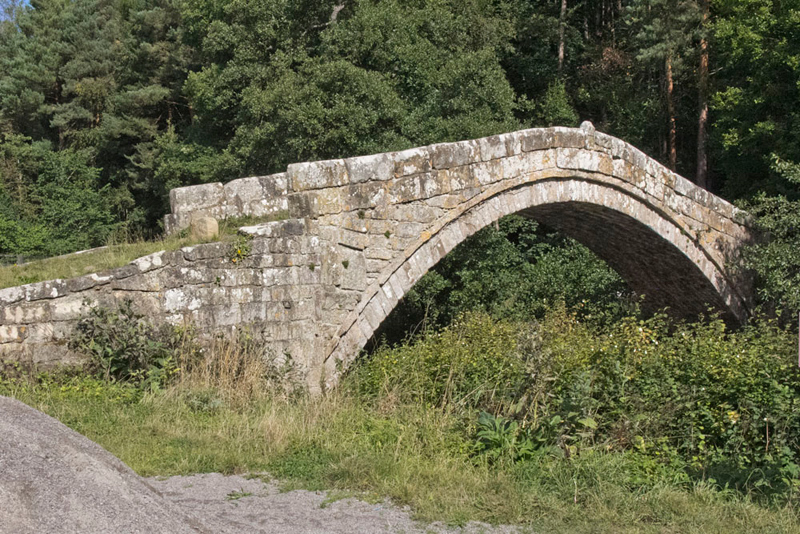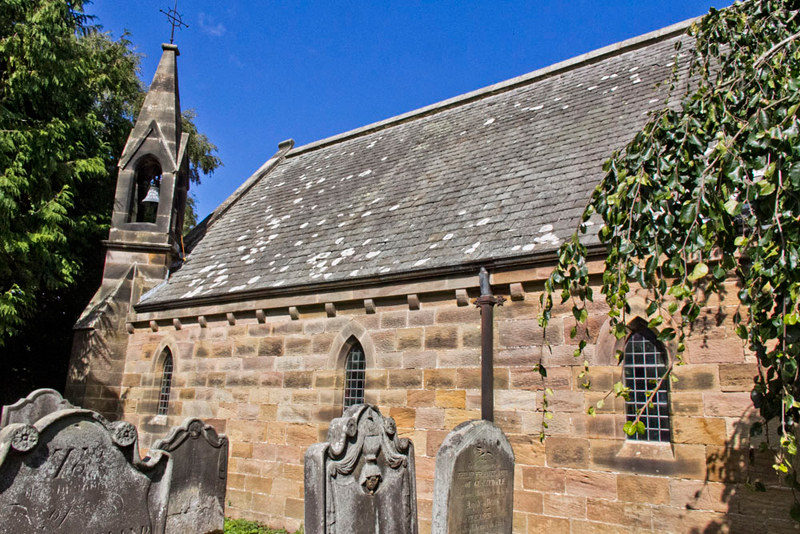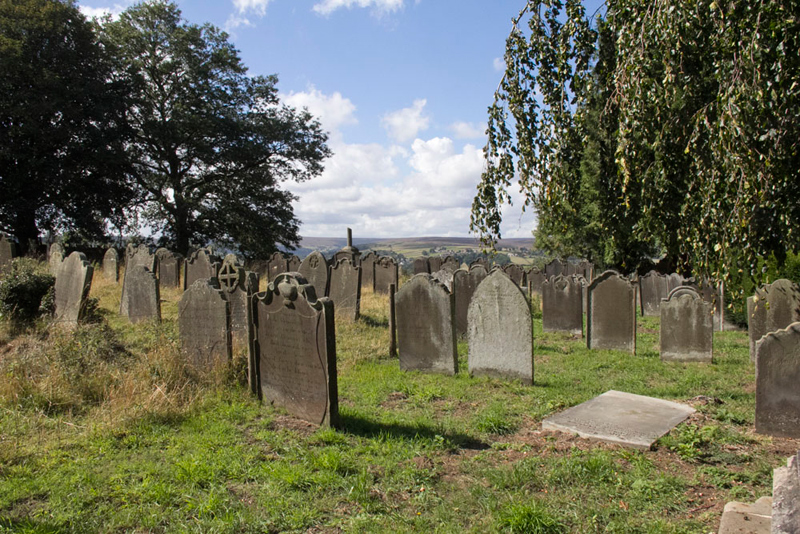Dad programmed the Satnav, that guided us to Glaisdale.
Not being exactly sure where the car park was, initially, after having crossed the river, we parked under the arches of the viaduct.
Shaun said, "actually the start is at the railway station, a little way uphill."
"Ok lad, we'll park there then."
The small parking area was completely empty, but Tetley pointed to a sign. "The car park is for rail customers only."
"Hmm", said Dad. "We would probably be fine staying here, but to be fair, we'll go back to the area under the viaduct."
"Let's go on the station first", suggested Southey. "We can have our picture taken, like the Railway Club bears do."
Here is the view along the platform. Little Eric said, "it's very well kept."
Dad carefully crossed the line to take this of the original station building. "I guess it is in private ownership now", commented Shaun.
Then recrossing again, took this of the waiting room on platform 2.
As can be seen there are lots of large planters. Seeing a notice, Allen said, "they are maintained by volunteers who also keep the station tidy."
"The signal box is all boarded up. No longer needed as the signals will be controlled from a central box, via the electronics in those metal boxes", guessed Grizzly.
Finally we posed on this seat.
Back at the arches, Dad got ready, while Shaun read the instructions. "We cross the river and walk up the road we drove in on. Actually we can cross via Beggars Bridge."
 |
There's an information panel about it", said Grizzly. "The medieval bridge had collapsed in 1577, and using some of the stone this replacement was built in 1619. The reputed construction is the result of the efforts of Thomas Ferris the son of a poor farm worker who lived on the opposite bank to the river from Agnes, the woman he loved. The story holds that Agnes was the daughter of the local squire, who forbade the two from marrying due to Ferris being poor. Ferris resolved to make his fortune at sea, but on the night of his departure was unable to say his goodbye to Agnes due to flooding that prevented him crossing the river. Upon making his fortune Ferris returned to marry Agnes, and afterwards became the Lord Mayor of Kingston-upon-Hull. He subsequently built the bridge so that other lovers would not suffer as he and Agnes had. Elements of the story may be apocryphal however, as it appears that Agnes died in 1618, with the bridge being built later. It has been suggested that it was a memorial to her rather than a crossing for others.
The bridge stretches 54 feet over the River Esk with a maximum width of 6 feet 6 inches. It is a scheduled monument and was grade II* listed in 1969."
We must have our picture sitting on the bridge", insisted Tetley.
We looked over the low parapet, for this view of the River Esk.
Finally now we got settled in the rucksack, and this shouldered by Dad, we crossed Beggars Bridge and then continued along the road.
"Just before the steep hill, we take the minor road left at the junction that follows the river," advised Shaun.
This took us along by lovely woodland.
Southey issued the next instruction. "Leave the road and take the access track right to Church Dale Farm."
Passing the farmhouse...
...and following the waymarks through the farmyard, we continued on a clear path uphill.
As we climbed, Little Eric called out, there's a beautiful view over the valley."
The path led through woodland, and beyond a gate we kept ahead with the hedge to the right. Then the path had tall hedging either side. Onwards through scrub to a stile into a field, heading towards Westony Farm.
"The path is paved", commented Allen.
Grizzly told us, "these are ancient pathways known as trods. They are common in this National Park and the oldest may date from medieval times when monks travelled extensively in the area. Most of the routes, however, probably came into being between the 17th and 19 centuries."
Joining the access to the farm, Shaun advised, "turn right to pass the farm."
After a gate, we followed the clear waymark directions. First right and the left through a gate, to walk down the fields, to a stile. The onwards downhill towards the woods to cross this ancient stone bridge with newer wooden parapets.
Beyond soon the path became narrow and wound steeply uphill, reaching the wall of a churchyard, and leading us to the left round it.
A sign at the gate into the churchyard told us this was Egton Mortuary Chapel.
 |
Grizzly obligingly read from the sign, placed there by Egton Parochial Church Council. -
"The Mortuary Chapel stands on the sight of the original St Hilda's Church, dedicated in June 1349, by the Bishop of Damascus, but was actually built much earlier.
The first Church eventually fell into disrepair
and after much discussion was demolished in 1878.
A new St Hilda's Church was built in Egton, its foundation stone being laid on Thursday 7 March 1878 and the first service held on 29 June 1879.
The present Mortuary Chapel i.e. for funerals, was built in 1897 by Mr John Hutchinson of Sleights, on the foundations of the former chancel of the 'Old Church' at a cost of £400 with the Foster family, owners of the Egton Estate, contributing half the cost together with all the stone.
Today the Mortuary Chapel is used for special services during the year. Although the building is normally locked, we welcome visitors
to its peaceful and ancient graveyard."
 |
Looking up, Tetley said, "the bell was made in 1861. Wonder if it was originally at the old church."
The chapel was indeed locked. Southey pointed, "there's a hole in the door. Perhaps you can get a shot of part of the interior, Dad."
From the chapel a wide track led to Egton Lane. "Turn left", called out Shaun. "We are then looking for a stile on the right into a field."
It was quite a little way and we kept our eyes peeled. Allen was the eagle-eyed one of us today, calling out, "here!"
To his dismay too there were sheep, and despite calling out "shoo", this one stood resolutely while Dad snapped its picture.
"Certainly not camera shy", laughed Tetley.
"Hmph", grumped Allen, "yet again there goes the sheep picture free story."
"We should call him after you, Shaun", laughed Grizzly, seeing his fleece had been clipped.
"Aye pal." He then gave us directions. "The route keeps pretty close to the hedges on the left all the time."
When Dad started heading to a gate in the middle, he called out, "we should veer left to that gate at the bottom."
Entering woodland, we walked the more of the trods.
"This stone trod is thought to be part of an ancient path to the site of St Hilda's Chapel, where the Mortuary Chapel stands now", informed Grizzly.
Further on the path narrowed and became railed where the ground dropped steeply away.
Through a gate we entered a field walking straight down and then bearing left at Lelum Hall Farm to the road at Egton Bridge, with the Postgate Inn at the junction.
A sloping path led to Egton Station. "We must visit" said Allen. Then adding, "our Railway Club pals will be interested to see the picture."
Little Eric said, "like Glaisdale is it very tidy and obviously looked after with the tubs of flowers and flower beds by the station building."
"Picture time", insisted Tetley. "On that seat by the building."
At the road Shaun instructed, it's right under the viaduct and then keep ahead at the junction."
Our progress was stopped by seeing St Hedda's Catholic Church.
"I have some notes", said Grizzly. "A Catholic chapel was in existence here by 1743, and it was replaced by a church in 1790. In 1867, it was replaced by the current, larger, church. The old church was converted into St Hedda's Catholic Primary School."
"We could hear the school children playing when we were at the station", interjected Allen. "The old church now the school must be the stone building with the bellcote surmounted by a cross, to the right"
"Built in stone with Welsh slate roof and terra-cotta ridge tiles, it consists of a nave, and north and south aisles with a wooden barrel vaulted roof." went on Grizzly. "The wooden pews are original as is the octagonal pulpit."
We walked on down to view the chancel and apse.
"Very elaborate", commented Tetley, seeing the wall paintings and the gilded altar and reredos.
"Indeed" agreed Grizzly. Turning he pointed to the organ gallery. "It has a mirror so the organist can see the body of the church."
As can be seen the camera flash has created a star effect, and obscuring what would have been a reflection of Dad.
The visit over, we continued on, Little Eric spotting the post box, Dad needing no prompting to take a picture for our pals collection.
The road bent right and crossed the River Esk via Egton Bridge.
Grizzly read from the plaque to inform us. "The bridge was reconstructed in 1993, to resemble the original structure of 1758, largely destroyed in the flood of 1930. It was opened on 16 February 1994 by County Counsellor F Robson, Chairman of North Yorkshire County Council. Further mention is given to Engineer M O Moore C Eng, County Surveyor, Main Contractor: Kier (NE), Boston Spa, and Mason: T H Atkinson Sleights."
Reaching the Horseshoe Hotel in a loop on the right, we kept straight ahead along the road signed to Rosedale.
"We drove along here to get to the start of our walk in Rosedale, when we stayed in June", stated Southey.
Shortly we met a father and son builders who were working at a house. The father said, "hello, where have you been walking"
"From Glaisdale to Egton Bridge and now back to the start."
"It is beautiful through East Arnecliff Wood", he replied.
Then followed a general lively chat about the area and Goathland with its association with Heartbeat.
Grand Yorkshire folk and a nice interlude.
Now on and on along the road to finally come to the signed track right, that as can be seen is part of the Coast to Coast path.
As the gentleman had said it was quite delightful strolling through East Arnecliff Wood.
The ancient stone trod was extensive for much of the way, Grizzly telling us "this is known locally as the 'Monk's Trod' and again is thought to be part of an ancient path to the site of St Hilda's Church."
"I suppose the widening of the path is because it is part of the Coast to Coast path", said Southey.
Up to now we had met no walkers, but along here a few couples passed in the opposite direction. They confirmed they were doing the Coast to Coast route. Dad had little chat with two couples. One American and the other Australian? Not far for them as another overnight stop and the final stretch would see them at Robin Hood's Bay.
The first part of our route was high above the River Esk, the path then descending to walk by it.
Reaching a junction, Shaun called out, "take the path right down the steps signed to Beggars Bridge."
Here we used the small footbridge to cross the stream by the ford, and walked under the viaduct to the car.
"What a super walk", cheered Shaun. "Thank you Dad once again for taking us."
"Aye", agreed Tetley. "It's been a grand day out in our home county Shaun."
We scrambled out and settled in the car, ready for our picnic.
"I intend to find somewhere for a snack on the way back" said Dad.
We kept our eyes peeled and as we neared Whitby, Little Eric called out, "look there's a cafe at Victoria Farm Garden Centre."
"Well spotted lad", Dad said as he pulled into the car park.
He went to the Abbey View Cafe, so called because there is such a fine view of the abbey ruins. Tea with extra hot water without asking, a cheese scone with butter and piece of delicious coconut slice, put Dad on until dinner.
Back at Saltmoore we rested while telling our other pals about our adventure.
Dad relaxed on the bed watching some TV, before going off for dinner in the Brasserie. Tonight is was the turn of our joint Chief Hug Bears, Gladly and Fred to accompany him. Once again they were liked by the waitresses.
They were the first members of the Hug, Fred, Gladly's brother, being our dear Uncle Brian's special bear. We often think that if Dad had not seen Gladly's cousin at the Silverdale Hotel, and later by mail order adopted Gladly, all our pals, the website etc., my never have happened.